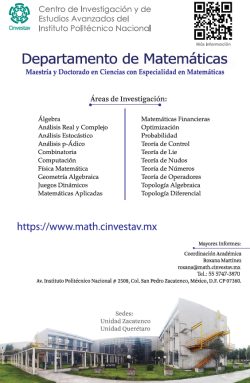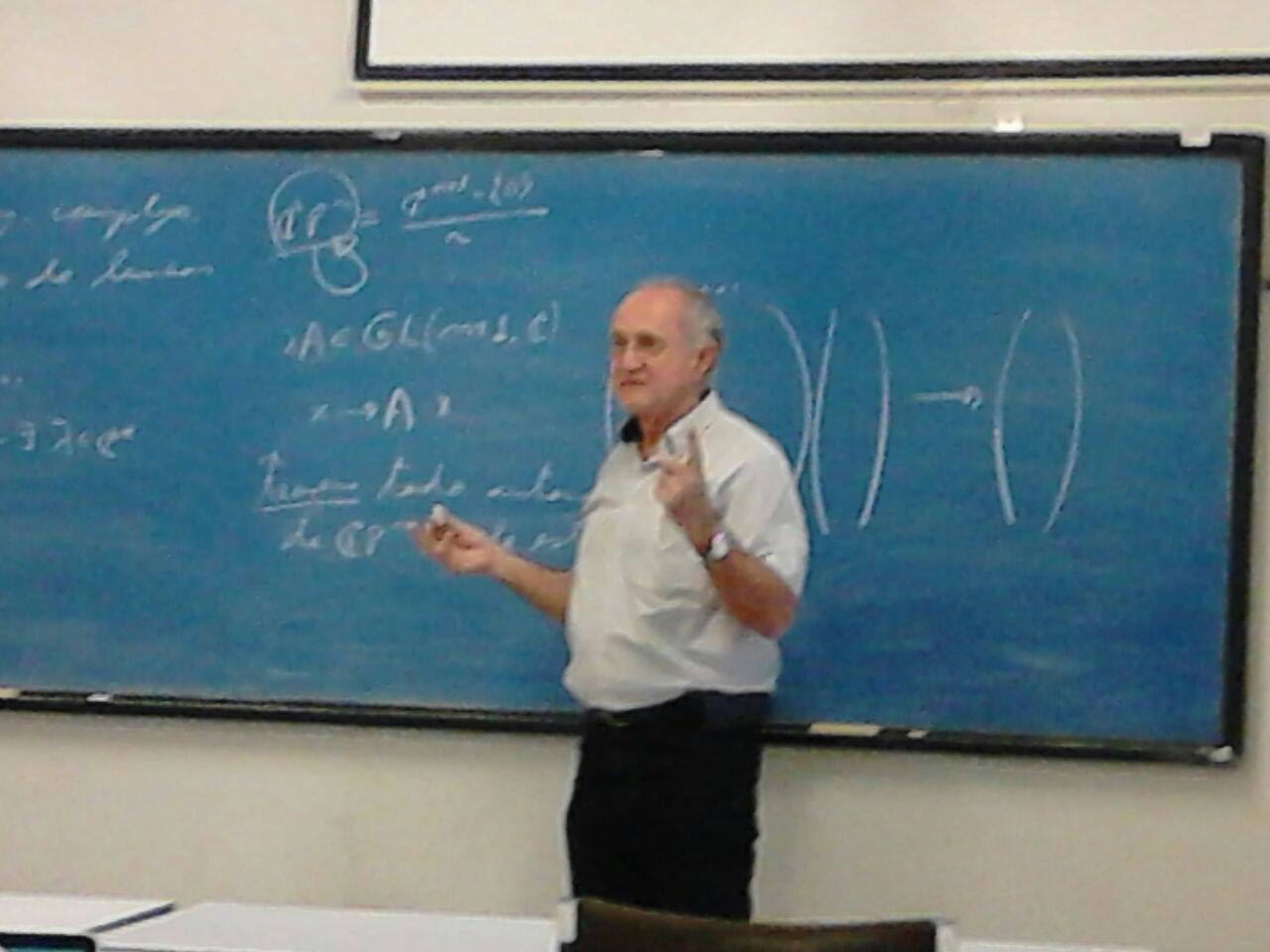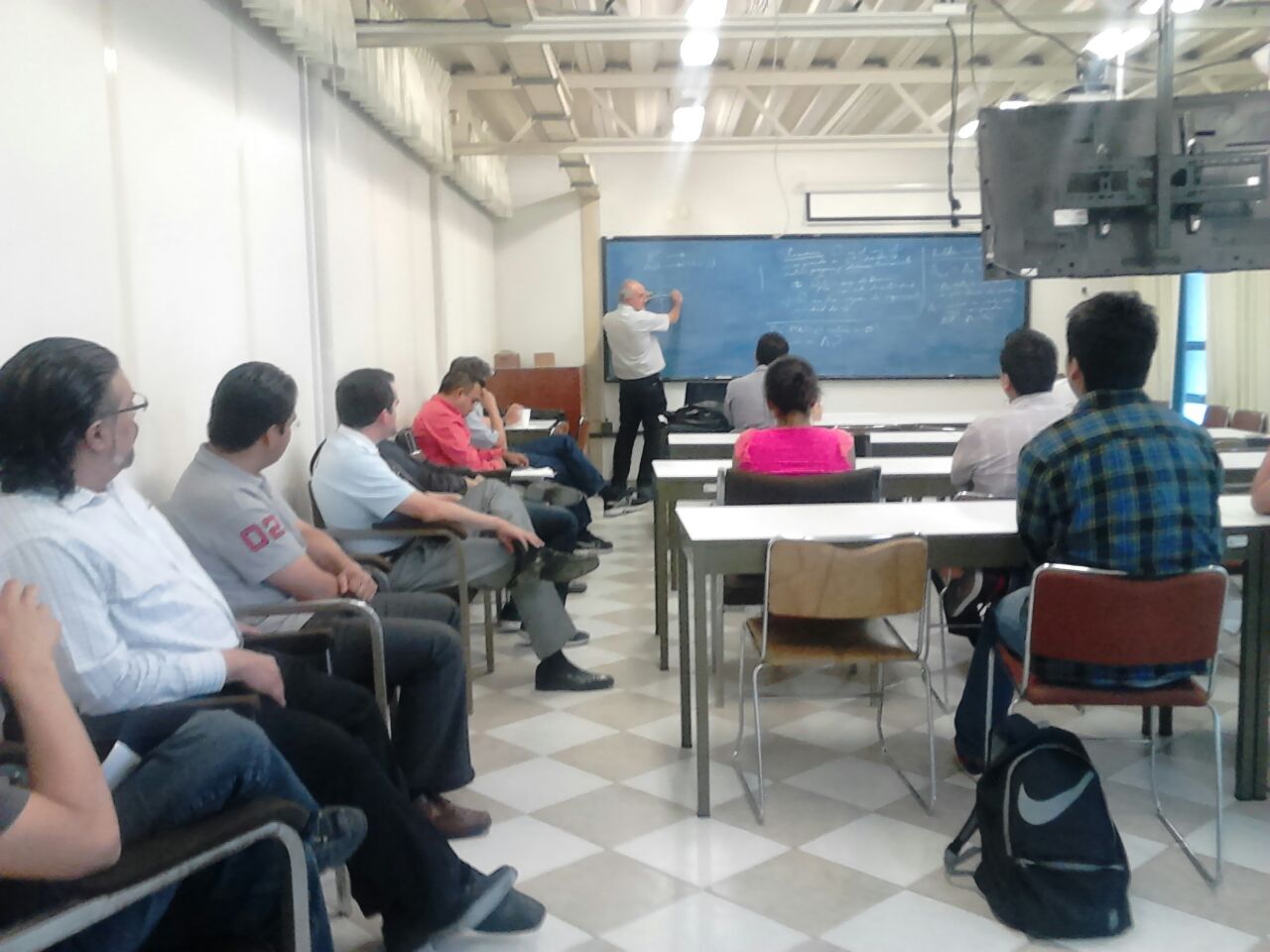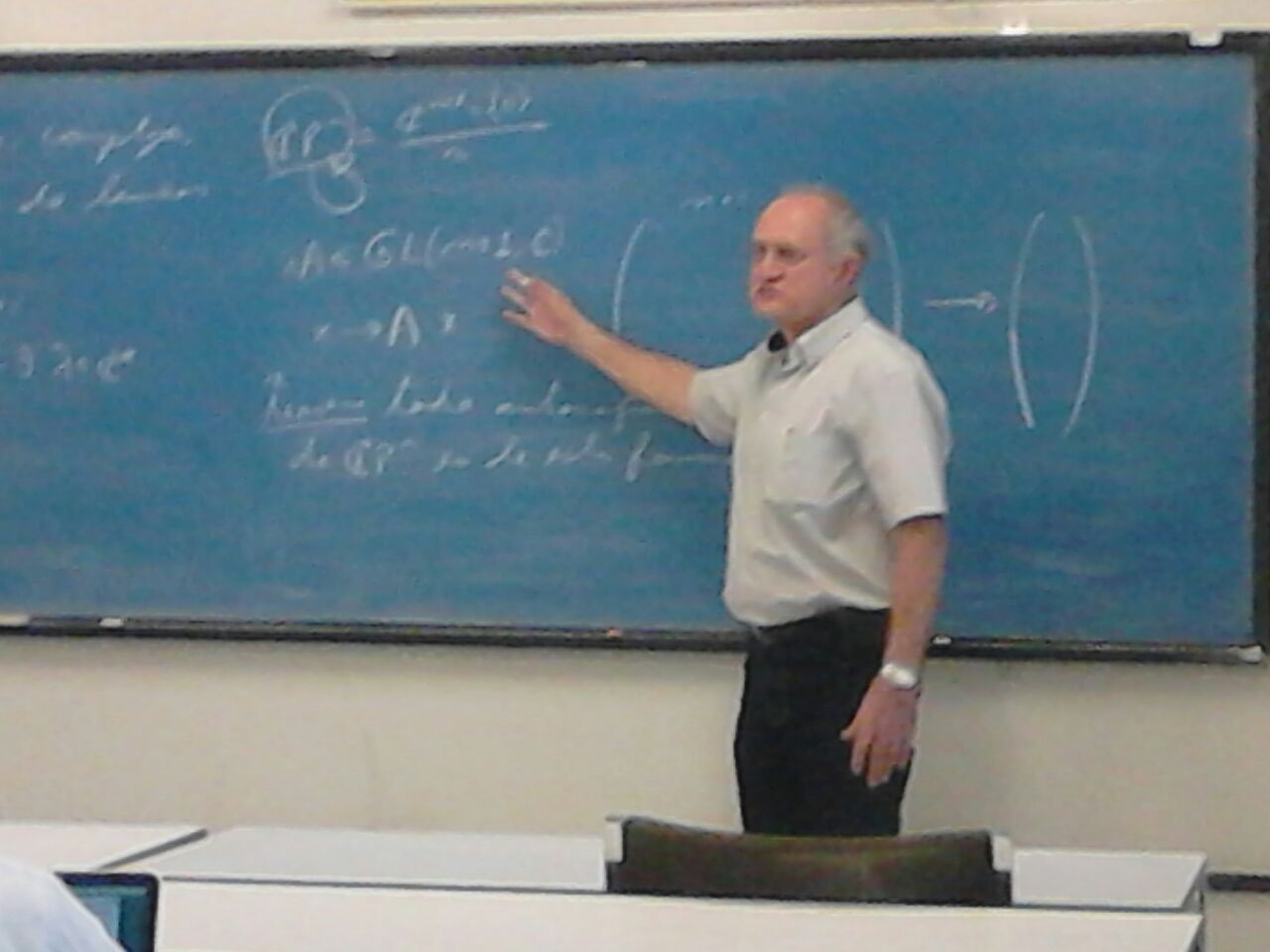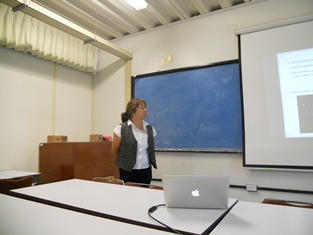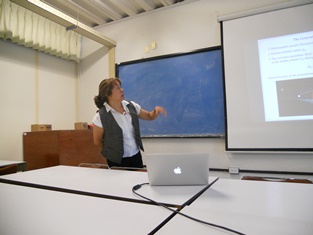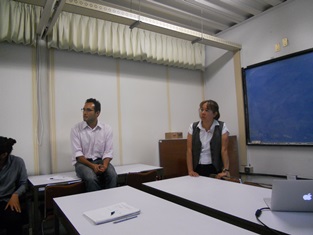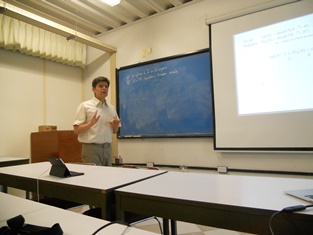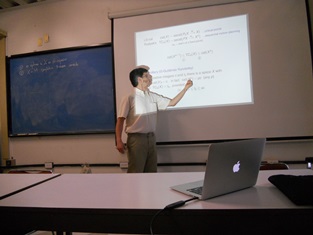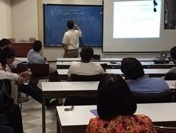Colloquium of Professors
The Department of Mathematics, Cinvestav-IPN invites you to the Colloquium of Professors, which will take place on Wednesday of each week at the Auditorium José Ádem at 16:00 PM.
Organizing Committee:
Juan Manuel Burgos
burgos [@] math.cinvestav.mx
February 20, 2019. Auditorium José Ádem, Cinvestav-IPN
16:00 Hrs.
Prof. Maxim Braverman
Northeastern University, Boston, USA
The spectral Flow of a family of Toeplitz operators
Abstract: We show that the (graded) spectral flow of a family of Toeplitz operators on a complete Riemannian manifold is equal to the index of a certain Callias-type operator. When the dimension of the manifold is even this leads to a cohomological formula for the spectral flow. As an application, we compute the spectral flow of a family of Toeplitz operators on a strongly pseudoconvex domain. This result is similar to the Boutet de Monvel's computation of the index of a single Toeplitz operator on a strongly pseudoconvex domain. Finally, we show that the bulk-boundary correspondence in a tight-binding model of topological insulators is a special case of our result.
November 21, 2018. Auditorium José Ádem, Cinvestav-IPN
16:00 Hrs.
Prof. Enrique Reyes
Department of Mathematics, Cinvestav-IPN
Monomial ideals associated with combinatorial structures
Abstract: .
November 14, 2018. Auditorium José Ádem, Cinvestav-IPN
16:00 Hrs.
M. Sc. Natalia Cadavid Aguilar
Department of Mathematics, Cinvestav-IPN
On the effective topological complexity of the orientable varieties of gender greater equal to 2
Abstract: .
November 7, 2018. Auditorium José Ádem, Cinvestav-IPN
16:00 Hrs.
Prof. Salvador Pérez Esteva
Institute of Mathematics, UNAM
Inverse problems for the Navier equation of linear elasticity
Abstract: .
October 17, 2018. Auditorium José Ádem, Cinvestav-IPN
16:00 Hrs.
Prof. Alma Itzel García Salas
Department of Mathematics, Cinvestav-IPN
Toeplitz operators with pseudo-homogeneous radial symbols on the disc
Abstract: .
October 10, 2018. Auditorium José Ádem, Cinvestav-IPN
16:00 Hrs.
Prof. Carlos G. Pacheco
Department of Mathematics, Cinvestav-IPN
The stochastic equation of heat and the concept of universality
Abstract: .
September 26, 2018. Auditorium José Ádem, Cinvestav-IPN
16:00 Hrs.
Prof. Eduardo Santillan Zeron
Department of Mathematics, Cinvestav-IPN
Applications of viscous solutions to the theory of several complex variables
Abstract: .
September 19, 2018. Auditorium José Ádem, Cinvestav-IPN
16:00 Hrs.
Prof. Luis Gorostiza
Department of Mathematics, Cinvestav-IPN
Stochastic Systems in Ultrametric Spaces
Abstract: .
September 12, 2018. Auditorium José Ádem, Cinvestav-IPN
16:00 Hrs.
Prof. Gregor Weingart
Institute of Mathematics, UNAM-Cuernavaca
Characteristic classes of symmetric and/or homogeneous spaces
Abstract: .
June 20, 2018. Auditorium José Ádem, Cinvestav-IPN
16:00 Hrs.
Prof. Pierre Py
Institute of Mathematics, UNAM
Hyperbolic cores
Abstract: .
June 13, 2018. Auditorium José Ádem, Cinvestav-IPN
16:00 Hrs.
Prof. Omar Antolín Camarena
Institute of Mathematics, UNAM
Commutativity in Lie Groups
Abstract: .
May 23, 2018. Auditorium José Ádem, Cinvestav-IPN
16:00 Hrs.
Prof. Ana Rechtman
Institute of Mathematics, UNAM
How to catch orbits of a flow?
Abstract: .
May 16, 2018. Auditorium José Ádem, Cinvestav-IPN
16:00 Hrs.
Prof. Mónica Clapp
Institute of Mathematics, UNAM
Symmetries and concentration on variational problems
Abstract: .
May 9, 2018. Auditorium José Ádem, Cinvestav-IPN
16:00 Hrs.
Prof. Alfredo Nájera
Institute of Mathematics, UNAM-Oaxaca
Conglomerate varieties and Teichmüller theory
Abstract: .
May 2, 2018. Auditorium José Ádem, Cinvestav-IPN
16:00 Hrs.
Prof. Daniel Labardini
Institute of Mathematics, UNAM
Surfaces with orbifold points and algebras parametrized by their first cohomology group
Abstract: .
April 25, 2018. Auditorium José Ádem, Cinvestav-IPN
16:00 Hrs.
Prof. Ferrán Valdez
Center for Mathematical Sciences of Morelia, UNAM
Big Mapping Class Groups
Abstract: .
April 18, 2018. Auditorium José Ádem, Cinvestav-IPN
16:00 Hrs.
Prof. Adolfo Guillot
Institute of Mathematics, UNAM
Complex differential equations with solutions without multivalued
Abstract: .
April 11, 2018. Auditorium José Ádem, Cinvestav-IPN
16:00 Hrs.
Prof. Laura Ortiz
Institute of Mathematics, UNAM
Invariants of the classification of differential equations and their foliations
Abstract: .
April 4, 2018. Auditorium José Ádem, Cinvestav-IPN
16:00 Hrs.
Prof. Alexander Mednykh
Sobolev Institute of Mathematics, Novosibirsk
Geometry of knots, links and polyhedra
Abstract: .
March 14, 2018. Auditorium José Ádem, Cinvestav-IPN
16:00 Hrs.
Prof. Alberto Verjovsky
Institute of Mathematics, UNAM
Varieties of Hilbert-Blumenthal over quaternions
Abstract: We try to generalize the construction of Hilbert-Blumental varieties for groups of matrices with entries in the quaternions. The inter-connection between several branches of mathematics comes into play.
March 7, 2018. Auditorium José Ádem, Cinvestav-IPN
16:00 Hrs.
Prof. Mikhail Belolipetsky
IMPA (Institute for Pure and Applied Mathematics) Brazil
Thickness of skeletons of hyperbolic orbifolds
Abstract: In 2011, Gromov and Guth proved a deep theorem relating hyperbolic volume, isoperimetric constant and thickness of an embedding of a hyperbolic manifold in Euclidean space. I will first discuss this theorem and its proof. After this, I will consider its generalization to orbifolds obtained in our joint recent work with Hannah Alpert. The talk will avoid technicalities and would be accessible to a general maths audience.
November 22, 2017. Auditorium José Ádem, Cinvestav-IPN
16:00 Hrs.
Prof. Feliú Sagols
Department of Mathematics, Cinvestav-IPN
Cryptocurrencies A response of mathematics and technology to the corruption of the international banking system?
Abstract: .
November 8, 2017. Auditorium José Ádem, Cinvestav-IPN
16:00 Hrs.
Prof. Ruy Fabila
Department of Mathematics, Cinvestav-IPN
Erdős-Szekeres type problems in integer grids
Abstract: In this talk we consider the problem of realizing, with integer coordinates of small size, well known point configurations in the plane. These sets are the extremal configurations of many well known Erdős-Szekeres type problems. We have proved lower bounds on the size of the integer grid needed to realize these configurations. Therefore, it is of interest to consider these problems in an integer grid such that their extremal configurations cannot be realized.
November 1, 2017. Cinvestav-IPN
13:00 Hrs.
Prof. Jesús González
Department of Mathematics, Cinvestav-IPN
Stochastic and Computational Algebraic Topology in the Robot Motive Planning
Abstract: .
October 18, 2017. Auditorium José Ádem, Cinvestav-IPN
16:00 Hrs.
Prof. Marcos Nahmad Bensusan
Department of Physiology, Biophysics and Neurosciences, Cinvestav-IPN
Mechanisms for controlling organ size and shape during development: Differentiation, proliferation and morphogenesis
Abstract: .
October 11, 2017. Auditorium José Ádem, Cinvestav-IPN
16:00 Hrs.
Prof. Ramón Vera
Institute of Mathematics, UNAM
Poisson structures in near-symplectic varieties
Abstract: .
October 4, 2017. Auditorium José Ádem, Cinvestav-IPN
16:00 Hrs.
Prof. Onésimo Hernández Lerma
Department of Mathematics, Cinvestav-IPN
An Introduction to Dynamic Games
Abstract: This is an introductory, non-technical presentation of some non-cooperative dynamic game themes. The presentation consists of three parts. The first is a general introduction to game theory, including some definitions and elementary examples, as well as some comments on the historical evolution of game theory. The second part presents definitions and models of dynamic deterministic and stochastic games. The third and final part deals with potential dynamic games, which form a class of games that we have developed in our Department of Mathematics in recent years.
September 27, 2017. Auditorium José Ádem, Cinvestav-IPN
16:00 Hrs.
Prof. Daniel Duarte
Autonomous University of Zacatecas
Nash's Explosions and the Nobile Theorem
Abstract: The Nash explosion of an algebraic variety separates singular points in terms of boundaries of tangent spaces. In this talk we will focus on some aspects of the problem of resolution of singularities with Nash explosions and its version of higher order. After giving a brief introduction to this problem, we will discuss a higher order version of Nobile's theorem which states that a variety is nonsingular if and only if it is isomorphic to its Nash explosion.
September 20, 2017. Seminar Room 238, Cinvestav-IPN
16:00 Hrs.
Prof. Daniel Labardini
Institute of Mathematics, UNAM
Surfaces with orbifold points and algebras parametrized by their first group of cohomology
Abstract: .
June 28, 2017. Auditorium José Ádem, Cinvestav-IPN
16:00 Hrs.
Prof. Alfonso Ruíz Guido
Oxford University
Infinitesimals: model theory v.s. algebraic geometry
Abstract: Model theory is a branch of mathematical logic that studies the category of definable sets using first order logic. It is known that there exists some category of definable sets which coincides with reduced algebraic varieties. It wasn't known that such category exists for non reduced algebraic varieties. I will first talk about this category that draws inspiration from a not widely known version of non commutative geometry introduced by Boris Zilber. The main objective of the talk is to compare the infinitesimals coming from model theory (in any category of definable sets!) and those coming from non reduced algebraic varieties à la Cartan-Grothendieck. If time permits I will try to explain some ideas of how quantum or string theoretic infinitesimals could fit in this picture. I will not assume any prior knowledge on model theory.
June 21, 2017. Auditorium José Ádem, Cinvestav-IPN
16:00 Hrs.
Prof. Juliho Castillo
Institute of Mathematics, UNAM
Geometric and viscosity solutions for the first-order Cauchy problem
Abstract: .
June 14, 2017. Auditorium José Ádem, Cinvestav-IPN
16:00 Hrs.
Prof. Luis Javier Carmona Lomeli
Cinvestav-IPN
Heavy Bergman Spaces
Abstract: .
June 7, 2017. Auditorium José Ádem, Cinvestav-IPN
16:00 Hrs.
Prof. Pablo Suárez Serrato
Institute of Mathematics, UNAM
Volume entropy bounds on smooth metric measure spaces
Abstract: We extend the notion of volume entropy to smooth metric measure spaces. We find upper bounds for this volume entropy on smooth metric measure spaces with Bakry-Émery Ricci tensors bounded below. These results use volume comparison theorems found for these spaces. As such, they also imply certain entropy vanishing results for the cases when these Bakry-Émery Ricci tensors are nonnegative. These results are examples of more general entropy bounds that can be obtained on metric measure spaces with a synthetic lower Ricci bound. This is joint work with Connell, Núñez-Zimbrón, Perales, Santos-Rodríguez, and Wei.
May 31, 2017. Auditorium José Ádem, Cinvestav-IPN
16:30 Hrs.
Prof. T. M. Gendron
Institute of Mathematics, UNAM
The modular quantum invariant and a solution of the real multiplication program in positive characteristic
Abstract: .
THURSDAY, MAY 25, 2017. Auditorium José Ádem, Cinvestav-IPN
16:00 Hrs.
Prof. José Antonio de la Peña
Institute of Mathematics, UNAM
Instituto Tecnológico Autónomo de México
Member of El Colegio Nacional
Entropy 2. comparing different entropies
Abstract: We analyze the differences between Shannon's entropy, von Neumann's and the entropy of graphs, and their relationship to Gibbs energy.
May 17, 2017. Auditorium José Ádem, Cinvestav-IPN
16:00 Hrs.
Prof. Victoria Lebed
Trinity College Dublin
How forgetting group laws leads to a universal knot invariant
Abstract: This talk is an advertisement for self-distributive (SD) structures. They sporadically appeared in mathematics since the late 19th century, either as an algebraic curiosity, or as an abstraction of the properties of different operations, such as Euclidean reflections or conjugation in a group. To be taken seriously, they had to wait the 1980's, which brought the construction of extremely efficient SD-based knot invariants, and the discovery of remarkable SD structures in large cardinal theory. Among more recent applications are Hopf algebra classification and the study of set-theoretical solutions to the Yang-Baxter equation.
May 3, 2017. Auditorium José Ádem, Cinvestav-IPN
16:00 Hrs.
Prof. Manuel Rivera
The City University of New York
Combinatorial models for road spaces
Abstract: .
16:00 Hrs.
Prof. Vladimir Vega
Department of Mathematics, Cinvestav-IPN
The category of superalmiares
Abstract: .
April 19, 2017. Auditorium José Ádem, Cinvestav-IPN
16:00 Hrs.
Prof. Otto Héctor Romero
Faculty of Sciences, UNAM
On the equidistribution of the horocyclic flow in dimension 3
Abstract: .
April 5, 2017. Auditorium José Ádem, Cinvestav-IPN
16:00 Hrs.
Prof. Carlos Segovia
Institute of Mathematics, UNAM, Oaxaca
Topological quantum field theories in high dimensions
Abstract: .
March 29, 2017. Auditorium José Ádem, Cinvestav-IPN
16:00 Hrs.
Prof. José-Antonio de la Peña
Entropies of graphs
Abstract: Entropies based on walks in graphs and in their line graphs are defined. They are based on the summation over diagonal and off-diagonal elements of the exponential of the adjacency matrix known as the network communicability. The walk entropies are strongly related to the walk regularity of graphs size and have significantly better correlation with the inverse participation ratio of the eigenmodes of the adjacency matrix than other graph entropies.
March 22, 2017. Auditorium José Ádem, Cinvestav-IPN
16:00 Hrs.
Prof. Nikita Kalinin
Department of Mathematics, Cinvestav-IPN
Brave new tropical world
Abstract: I start with short description of the moduli space of algebraic curves, define tropical curves as certain degeneration of complex curves and explain why they are useful in different branches of mathematics. If time permits, I will define phase-tropical curves, which have more structures on them.
March 15, 2017. Auditorium José Ádem, Cinvestav-IPN
16:00 Hrs.
Prof. Adrián Zenteno
UNAM, University of Barcelona
The Langlands program and some cases of the Galois inverse problem
Abstract: .
March 8, 2017. Auditorium José Ádem, Cinvestav-IPN
16:00 Hrs.
Prof. María Ronco
Instituto de Matemáticas y Física, Universidad de Talca, Chile
Combinatorial Hopf algebras and non-symmetric operads: two examples
Abstract: Combinatorial Hopf algebras are Hopf algebras whose underlying vector space is spanned by a graded set of combinatorial objects (like, trees, permutations, maps between finite sets, . . . ) in such a way that the bialgebra structure is induced by natural operations on them.
On the other hand, to describe a algebraic operad P it suffices to know the free object of the theory. In many examples, combinatorics give the adequate tools to construct them. When these free objects are equipped with a coproduct, satisfying certain relations with the operations of P, we get a notion of P bialgebra. For instance, when P is the operad of associative algebras, the free associative algebra over a vector space V is the tensor algebra T (V ) which is equipped with the shuffle coproduct Δsh, which is an algebra homomorphism.
We shall introduce basic definitions and examples of combinatorial Hopf algebras, and of non-symmetric operads. Our aim is to illustrate the relationship between algebraic operads and combinatorial Hopf algebras with two examples:
- we shall consider the set of p-Dyck paths, for p ≥ 1, and we shall construct a family of non-symmetric operads Dyckp, whose free objects are described in terms of p-Dyck paths. When p = 1, the operad Dyck1 is J.-L. Loday operad of dendriform algebras, while Dyck0 is the operad of associative algebras. This is a joint work with D. Lopéz N. and L.-F. Préville-Ratelle.
- for the second example, our depart point will be the operad of differential 2-associative algebras. We shall describe such structure in spaces spanned by guillotine floorplans. This is a joint work with I. Gálvez C. and A. Tonks.
In both cases, the free objects are combinatorial Hopf algebras.
November 23, 2016. Auditorium José Ádem, Cinvestav-IPN
16:00 Hrs.
Prof. Armando Cabrera Pacheco
University of Connecticut
About Geometry of Initial Data Sets for Einstein's Equations
Abstract: The Riemannian varieties of non-negative scalar curvature naturally arise as initial sets of Cauchy's problem for Einstein's equations (with temporal symmetry). Among other properties, these varieties have a well defined notion of mass and represent spatial surfaces of isolated gravitational systems (such as a star or a black hole). The Riemannian Penrose inequality provides a lower bound for the mass of these varieties in terms of the event horizon geometry, with equality if and only if the variety is a spatial Schwarzschild variety. In this talk we will give an overview of the geometry of these initial data sets and some recent results on the instability of Riemannian Penrose inequality.
October 26, 2016. Auditorium José Ádem, Cinvestav-IPN
16:00 Hrs.
Prof. Olivier Mathieu
Institut Camille Jordan, Lyon
Self-similarity for τ groups
Abstract: Let G be a group. In what follows G will be infinite but finitely generated. Given a subgroup H, the core is the biggest subgroup K of H which is normal in G. Indeed the core is the kernel of the action of G on G / H and so K has finite index whenever [G : H] < ∞. This means that using group actions without an additional datum is not enough to understand the infinite group G.
October 19, 2016. Auditorium José Ádem, Cinvestav-IPN
16:00 Hrs.
Prof. Michael Polyak
Technion, Haifa
Invariants of 3-manifolds by counting subgraphs
Abstract: We introduce a simple combinatorial encoding of 3-manifolds by planar graphs. In this setting, perturbative Chern-Simons invariants turn into a weighted counting of appropriate subgraphs.
October 12, 2016. Auditorium José Ádem, Cinvestav-IPN
16:00 Hrs.
Prof. Vladimir Dotsenko
Department of Mathematics, Cinvestav-IPN
Pattern avoidance in permutations
Abstract: A permutation w is said to contain another permutation w' as a (consecutive) pattern if there is a subword of w that is order-isomorphic to w', otherwise w is said to avoid w'. Enumeration of permutations avoiding a given set of patterns is a challenging combinatorial question. I shall explain an approach to enumeration questions like that which is motivated by homological algebra, more precisely by adapting a celebrated construction of David Anick to the case of so called shuffle algebras. All necessary definitions will be given in the talk.
September 28, 2016. Auditorium José Ádem, Cinvestav-IPN
16:00 Hrs.
Prof. Pierre Py
UNAM
Cubulable Kähler groups
Abstract: I will recall the definition of a CAT(0) cubical complex. This is a special type of polyhedral complex which played an important role in geometric group theory recently. An aspherical manifold is cubulable if its fundamental group acts freely cocompactly properly discontinuously on a CAT(0) cubical complex. It was proved recently that any closed hyperbolic 3-manifold is cubulable, this was a key step in the proof by Agol of the virtual Haken conjecture. In this talk I will explain why, on the other hand, the only cubulable smooth projective manifolds are the obvious ones. Up to finite cover, they are products of Riemann surfaces and tori. This is joint work with Thomas Delzant.
September 21, 2016. Auditorium José Ádem, Cinvestav-IPN
16:00 Hrs.
Prof. Raúl Quiroga
CIMAT
Analysis and geometry in complex domains
Abstract: .
September 14, 2016. Auditorium José Ádem, Cinvestav-IPN
16:00 Hrs.
Prof. Kevin Esmeral García
Universidad de Sucre, Sincelejo, Colombia
Radial measures Fock-Carleson type for derivatives
Abstract: In this talk we present, radial type Fock-Carleson measures for derivatives of order k of functions in the Fock space (or Segal-Bargmann). A criterion for regular action on the complex plane radials are given. In addition, due to measures Fock-Carleson type are directly related to Toeplitz operators whose symbols are measured, a standard that establishes when Toeplitz operators generated by derivatives of order k Fock-Carleson type measures are radials are given. Finally, it is shown that the C *-algebra generated by these radial Toeplitz operators is commutative.
September 7, 2016. Auditorium José Ádem, Cinvestav-IPN
16:00 Hrs.
Prof. Raffael Hagger
Leibniz Universität, Hannover, Alemania
On the essential spectrum of Toeplitz operators
Abstract: Consider the usual function space L2(D) on the unit disk D={z in C : |z| < |} and the (closed) subspace of holomorphic functions A2(D). An important class of bounded linear operators arises by restricting multiplication operators Mf on L2(D) to A2(D). More precisely, if P denotes the orthogonal projection onto A2(D), one considers operators of the form PMf|A2(D), so-called Toeplitz operators. In this talk we are going to study the essential spectrum of these Toeplitz operators. It is a classical result that if the defining symbol f is continuous up to the boundary, the essential spectrum can be obtained by evaluating f at the boundary. As it turns out, this statement can be generalized to more general symbols by using techniques that were devloped to solve similar problem on the sequence space ell2(Z).
June 8, 2016. Auditorium José Ádem, Cinvestav-IPN
16:00 Hrs.
Prof. Jawad Snoussi
UNAM
On the equi singularity in families of complex analytic spaces
Abstract:
May 11, 2016. Auditorium José Ádem, Cinvestav-IPN
16:00 Hrs.
Prof. Gerardo Arizmendi
CIMAT
Twistor space of a Riemannian manifold with structure Clifford couple
Abstract:
April 27, 2016. Auditorium José Ádem, Cinvestav-IPN
16:00 Hrs.
Prof. Luis Jorge Sánchez Saldaña
CCM-UNAM, Morelia
Whitehead group of Hilbert modular group
Abstract:
April 20, 2016. Auditorium José Ádem, Cinvestav-IPN
16:00 Hrs.
Prof. Ferrán Valdez
CCM-UNAM, Morelia
Trees, stairs and monsters
Abstract:
April 6, 2016. Auditorium José Ádem, Cinvestav-IPN
16:00 Hrs.
Prof. Juan Manuel Burgos
Institute of Mathematics, Cuernavaca campus, UNAM
Surface Teichmüller spaces
Abstract:
March 30, 2016. Auditorium José Ádem, Cinvestav-IPN
16:00 Hrs.
Prof. Pablo Suárez Serrato
Institute of Mathematics, UNAM
Poisson structures in dimension 4
Abstract:
March 16, 2016. Auditorium José Ádem, Cinvestav-IPN
16:00 Hrs.
Prof. Gelasio Salazar
UASLP
Incursions in probability from geometry and discrete mathematics
Abstract: Platicaré sobre dos problemas que hemos trabajado recientemente, cuyo (único) denominador común es que conjugan probabilidad y matemáticas discretas. El primer problema es: ¿cuántas páginas se necesitan para encajar una gráfica? El modelo de encaje de páginas en libros tiene aplicaciones en varias áreas de la teoría de computación; la idea es que los vértices de la gráfica se colocan en el "lomo" del libro, cada arista va en una "página", y se prohíben cruces de aristas. Platicaré brevemente sobre nuestro avance en este problema, incluyendo su relación con problemas clásicos de permutaciones. El segundo problema del que hablaré es de naturaleza geométrica. Supongamos que elegimos aleatoriamente n puntos de un conjunto convexo K en el plano (por simplicidad, aunque todos nuestros resultados aplican para cualquier dimensión); un "hoyo" es un subconjunto de K que no contiene ninguno de estos n puntos. La pregunta que resolvimos fue: ¿cuál es el tamaño esperado del "hoyo" convexo más grande? Esta plática consiste de resultados obtenidos con József Balogh y con Octavio Arizmendi.
September-December, 2015 |
March-July, 2015 |
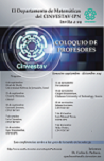 |
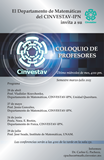 |
December 9, 2015. Auditorium José Ádem, Cinvestav-IPN
12:00 Hrs.
Prof. Mike Porter
Cinvestav-IPN
What are Quadratic Differential?
Abstract: In several recent talks in this seminar, was mentioned the "Teichmüller space" in various contexts, such as moduli spaces, Riemann surfaces, etc. One of the main elements for understanding the Teichmüller space is the notion of quadratic differential. This concept is explained and how it is used to build the Teichmüller space.
December 2, 2015. Auditorium José Ádem, Cinvestav-IPN
16:00 Hrs.
Prof. Luis Manuel Tovar
ESFM-IPN
Weighing functions
Abstract: We consider spaces (or classes) of analytic or harmonic functions in the unit open disk; or holomorphic in the unit ball of Cn; or hyper-holomorphic defined in the three-dimensional unit ball. The idea is to achieve stratification of these families in terms of their behavior when approaching the boundary of its domain of definition.
November 25, 2015. Auditorium José Ádem, Cinvestav-IPN
16:00 Hrs.
Prof. Johana Luviano
Cinvestav-IPN
Shellability and Cohen-Macaulay property in Cayley graphs
Abstract: One of the main goals of the now called combinatorial commutative algebra is to make a dictionary between properties of algebraic objects and properties of combinatorial objects. One such example is the bijective correspondence between simple hyper-graphs and square free monomial ideals. This correspondence can relate invariants of both objects, for example the cover number of a simple hypergraph matches up to its corresponding ideal monomial. Another important correspondence is called Stanley Reisner, between simple hypergraphs and simplicial complexes. From this perspective, some important properties are: decomposed by vertices, Cohen-Macaulay shellability and be well covered. In this talk we will study these properties for independence complexes Cayley graph, circulating graphs, super-generalized Petersen graphs, and some other graphics.
November 17, 2015. Auditorium José Ádem, Cinvestav-IPN
16:00 Hrs.
Prof. Grigori Rozenblum
Chalmers University of Technology
Complex variables in real problems: a case study. Toeplitz operators
Abstract: It happens sometimes that in a mathematical problem concerning real variables, it becomes necessary to introduce a complex variable, sometimes in a rather fancy way. In the talk we are going to discuss some classical examples and explain how complex analysis helps to study eigenvalue distribution of Toeplitz operators.
November 12, 2015. Room 031, Department of Mathematics, Cinvestav-IPN
16:00 Hrs.
Prof. Alexei Rybkin
University of Alaska Fairbanks
The Hankel and Toeplitz operator approach to completely integrable PDEs
Abstract: As well-known, many problems in the theory of completely integrable systems can be formulated in terms of Riemann-Hilbert boundary problems. This has been used (explicitly or implicitly) since the late 1980s. On the other hand, it is also well-known that the Riemann-Hilbert problem is closely related to the theory of Hankel and Toeplitz operators. Moreover, since the 1960s (and implicitly even earlier) the former has stimulated the latter. But, surprisingly enough, while having experienced a boom at the same time, soliton theory and the theory of Hankel and Toeplitz operators have not shown much of direct interaction.
In the KdV context, we construct a Hankel operator which symbol is conveniently represented in terms of the scattering data for the Schrodinger operator associated with the initial data. Thus the spectral properties of this Schrodinger operator can be directly translated into the spectral properties of the Hankel operator. The latter then yield properties of the solutions to the KdV equation through explicit formulas. This allows us to recover and improve on many already known results as well as a variety of new ones. The main feature of this approach is that it applies to large classes of initial data far beyond the classical realm. For instance, we can handle low regularity initial data, lift any decay assumption at minus infinity, and significantly relax the decay at plus infinity. In this talk we discuss some representative results in this context focusing on well-posedness issues and basic properties of underlying solutions.
Our approach is not restricted to the KdV. Moreover, we believe that the interplay between soliton theory and Hankel operators may be even more interesting and fruitful for some other integrable systems with richer than KdV structures.
The talk is based on joint work with Sergei Grudsky.
November 11, 2015. Auditorium José Ádem, Cinvestav-IPN
16:00 Hrs.
Prof. Kristin Shaw
University of Toronto
Matroids and smoothness in tropical geometry
Abstract: Tropical geometry can be considered as algebraic geometry over the max-plus semi-field. Varieties over this semi-field are polyhedral in
nature and may arise by tropicalizing varieties over a field. This has led to many applications of this relatively new geometry to classical algebraic geometry.
However, not all tropical varieties arise in this way. One example is tropical linear spaces which are locally given by matroids. Matroids are a combinatorial abstraction of the notion of independence from linear algebra or graph theory, and were introduced by Whitney. It is well known that there exist matroids which are not representable over any field, yet every matroid is representable as a tropical linear space.
In this talk, I will explain some surprising ways in which tropical spaces build from matroidal fans retain properties of smooth spaces from differential or algebraic geometry. Examples include intersection theory, adjunction formulas, and Poincare duality of tropical homology groups.
October 28, 2015. Auditorium José Ádem, Cinvestav-IPN
16:00 Hrs.
Prof. Oleg Kudryavtsev
Russian Customs Academy Rostov Branch
Fast numerical methods to solve partial integro-differential equations arising in mathematical finance
Abstract: In the talk, efficient numerical methods for solving a special class of partial integro-differential equations are presented. The problems under consideration arise in mathematical finance to price options in Levy models. The methods are based on an efficient approximate Wiener-Hopf factorization and a numerical inversion of the Laplace transform.
The idea behind the approach is to transform the problem to a space where the solution is relatively easy to obtain by using the Wiener-Hopf method.The Laplace transform maps the generalized Black-Scholes equation with the appropriate boundary conditions into the one-dimentional problem on the half-line parametrically dependent on the transform parameter.
In the first approach, we solve the problems obtained by using the approximate Wiener-Hopf factorization at real positive values of the transform parameter specified by the Gaver-Stehfest algorithm. Then option prices are recovered via the numerical inversion formula.
The second approach is based on the Post-Widder formula; we find out the Nth derivative of the transformed function at the certain transform parameter value by using an iterative procedure which can be interpreted as Carr's randomization. We repeat the procedure several times for different values of N and apply the convergence acceleration algorithm.
The advantage of the methods in terms of accuracy and convergence are shown by using finite difference schemes and Monte-Carlo simulations. Apart from methods for particular cases where Laplace transform is given by an explicit expression, the proposed methods are applicable for the general case. The methods enjoy an additional appealing feature: they produce a set of option prices at different spot levels, simultaneously.
October 14, 2015. Auditorium José Ádem, 16:00 hrs. Department of Mathematics, Cinvestav-IPN
16:00 Hrs.
Prof. Egor Maximenko
ESFM-IPN
The quantile function and uniform approach of the eigenvalues of Toeplitz matrices
Abstract: Toeplitz matrices have been studied intensively over the last 100 years, due to their applications in signal processing and various models of physics. The asymptotic distribution of eigenvalues described by the Szegő theorem, but the approach of their individual values and eigenvectors is still an open problem.
In the talk it shows how to "flip" Szegő theorem and derive an approximate formula for the eigenvalues of Toeplitz matrices (see interactive examples).
The main tool is the quantile function. It turns out that convergence in distribution under certain natural conditions implies the uniform convergence of the quantile functions. At the end a couple of applications outside the world of matrices mentioned, namely the inverted equal-distribution of Weyl and arcsine law for random walks versions.
October 7, 2015. Auditorium José Ádem, 16:00 hrs. Department of Mathematics, Cinvestav-IPN
16:00 Hrs.
Prof. Luis Gorostiza
Cinvestav-IPN
Percolation, self-avoidant random walks, and Schramm-Loewner evolution
Abstract: The Schramm-Loewner evolution (SLE) combines the stochastic analysis and complex analysis, to study properties of limits, with rescaling of curves and random planar graphs that arise in percolation, self-avoidant random walks and other stochastic models in theory of probability and mathematical physics. These limits are invariant under conformal transformations. SLE have made significant progress and have confirmed some conjectures, which has resulted in two Fields Medals in the last decade. In the discussion they are presented (somewhat technical) some general issues regarding percolation, self-avoidant random walks (caused by the excluded volume problem in polymers), some other problems solved and unsolved. These and related issues (such as the use of the theory of electrical circuits for random walks in disordered media) are already part of textbooks and master programs courses.
September 30, 2015. Room 131, 16:00 hrs. Department of Mathematics, Cinvestav-IPN
16:00 Hrs.
Prof. Gerardo Jiménez
Cinvestav-IPN
Spectrum of lengths metrics in Teichmüller spaces
Abstract: In this talk we first define the concept of Riemann surface. Then we build Teichmüller space Tg of Riemann surfaces of genus g, which, broadly speaking, is the space that parameterizes, the cuasiconform marked surface deformations. dT Teichmüller metric measures how close are two Riemann surfaces in this space to be conformally equivalent. Furthermore, the metric of lengths dL spectrum, compares the geodesic lengths of two Riemann surfaces to determine a distance between them. Both metrics define the same Tg topology. However, during the talk we will discuss that for compact Riemann surfaces of genus g > 1 spaces (Tg , dT ) and (Tg , dL) are not equivalent as metric spaces.
September 23, 2015. Room 131, 16:00 hrs. Department of Mathematics, Cinvestav-IPN
16:00 Hrs.
Prof. Claudio Meneses
CIMAT
An introduction to the Hitchin system on moduli spaces
Abstract: A prime example in the theory of integrable systems is the problem of rigid body. A vast generalization of the system was discovered by Hitchin in the context of the theory of moduli of Higgs bundles. The Hitchin integrable system is a prime example of the rich geometric structure inherent in moduli spaces of bundles of Higgs.
This talk will describe, relatively elementary way and with concrete examples, different interpretations of these spaces (complex geometry, gauge theories, representations of discrete groups), the symplectic structure and Hitchin system construction in the case G = SU (2). If time permits, I will describe work in progress on a guess of calculating volumes symplectic moduli space of stable bundles (originally calculated by Witten) based on the system Hitchin.
September 4, 2015. Room 131, 12:00 hrs. Department of Mathematics, Cinvestav-IPN
12:00 Hrs.
Prof. Ehud de Shalit
The Hebrew University of Jerusalem, Israel
Geometry of p-adically uniformized varieties
Abstract: P-adic numbers were invented by Hensel to encode solutions to congruences modulo all powers of a prime number p. "Soft" p-adic analysis allows one to talk about p-adic manifolds, p-adic Lie groups etc., but a major obstacle is that the p-adic world is totally disconnected. This was overcome by Tate in the 1960's, with the invention of Rigid Analytic Geometry.
Quotients of p-adic symmetric domains by discrete groups of automorphisms can be algebraized, as was done by Klein, Fuchs and Poincare in the classical setting. The ensuing class of p-adically uniformized varieties has important applications to number theory.
We shall survey this line of development, ending with results of the speaker from 2005 on the Monodromy-Weight conjecture for p-adically unifromized varieties.
July 29, 2015. Room 131, 16:00 hrs. Department of Mathematics, Cinvestav-IPN
16:00 Hrs.
Prof. José Seade
Institute of Mathematics, UNAM
Transformation groups of complex projective spaces
Abstract: Classical Kleinian groups are discrete groups of automorphisms of the projective space CP1, which is equivalent to two-dimensional sphere S2. This talk will discuss generalizations of these groups, to projective transformations of higher dimensional spaces.
June 24, 2015. Room 131, 16:00 hrs. Department of Mathematics, Cinvestav-IPN
16:00 Hrs.
Prof. Nora. E. Bretón
Department of Physics, Cinvestav-IPN
Light scattering by a black hole
Abstract: In this symposium is introduced the solution of the Einstein equations simpler, and the Schwarzschild solution, which is a black hole.
In this space-time static and spherically symmetric trajectories of light rays are studied, which can be deflected by a black hole at angles up to multiples of Pi, presenting effects as "glory," "photosphere" or the "shadow of a black hole"
If time permits, briefly semiclassical approach will be outlined.
May 27, 2015. Room 131, 16:00 hrs. Department of Mathematics, Cinvestav-IPN
16:00 Hrs.
Prof. Jesús González
Department of Mathematics, Cinvestav-IPN
Algebraic topology in motor planning mechanical arms
Abstract: In this talk I describe the topological complexity of what is known as polyhedral products. This helps in applications of robotics. An important point of the problem is the combinatorial restrictions on the number of simultaneous rotating nodes.
April 29, 2015. Room 131, Department of Mathematics, Cinvestav-IPN
16:00 Hrs.
Prof. Vladislav Kravchenko
Department of Mathematics, Cinvestav-IPN, Querétaro campus
Transmutation operators: introduction and new applications
Abstract: Since the first report of J. Delsarte 1938, transmutation operators (or: transformation) represent one of the main tools in the spectral theory of differential operators (eg, [1-5]). In particular, it is well known that for operators A = − d2⁄dx2 + q(x) and B = −d2⁄dx2, q ∈ C[-b; b], There is an operator T such that ATu = TBu for any u ∈ C2[b; b] and also has the form of a Volterra operator

with a core K of class C1.
The knowledge of transmutation operator reduces the complicated equation Ay = λy (λ is a complex number called spectral parameter) to a basic equation By = λy. However, finding the core K for a given function q, represents a difficult problem, which transmutation operators have until recently, been a largely theoretical tool and have not been applied to the practical solution of spectral problems.
In recent works [6-9] have revealed several new properties transmutation operators, their relationship with the theory of pseudo-analytic functions [10] and as a result has developed a method for building the kernel K and solution of spectral problems associated with the operator A, and Sturm-Liouville operators more complicated. Numerical implementation has shown that the method obtained, unlike other known methods, can find thousands (!) Of the values and characteristics of a spectral problem functions, all with the same (either to λ1 or λ10000) and remarkable precision.
Will give a brief introduction to the discussion on the subject of transmutation operators as well as recent theoretical developments and practical applications.
- J. Delsarte and J. L. Lions, Transmutations d'opérateurs différentiels dans le domaine complexe, Comment. Math. Helv., 32 (1956), 113-128.
- V. A. Marchenko, Sturm-Liouville Operators and Applications. Birkhäuser, Basel, 1986.
- B. M. Levitan, Inverse Sturm-Liouville problems, VSP, Zeist, 1987.
- H. Begehr and R. Gilbert, Transformations, transmutations and kernel functions, vol. 1-2, Longman Scientific & Technical, Harlow, 1992.
- S. M. Sitnik, Transmutations and applications: a survey, arXiv:1012.3741v1, originally published in the book: Advances in Modern Analysis and Mathematical Modeling, Editors: Yu.F.Korobeinik, A.G.Kusraev, Vladikavkaz: Vladikavkaz Scientific Center of the Russian Academy of Sciences and Republic of North Ossetia-Alania, 2008, 226-293.
- H. Campos, V. V. Kravchenko and S. M. Torba, Transmutations, L-bases and complete families of solutions of the stationary Schrödinger equation in the plane, J. Math. Anal. Appl., 389 (2012), no. 2, 1222-1238.
- V. V. Kravchenko and S. Torba, Transmutations for Darboux transformed operators with applications, J. Phys. A: Math. Theor., 45 (2012), # 075201 (21 pp.).
- V. V. Kravchenko and S. M. Torba, Construction of Transmutation Operators and Hyperbolic Pseudoanalytic Functions. Complex Anal. Oper. Theory 9 (2015), no. 2, 379-429.
- V. V. Kravchenko and S. M. Torba, Analytic approximation of transmutation operators and applications to highly accurate solution of spectral problems. J. Comput. Appl. Math. 275 (2015), 1-26.
- V. V. Kravchenko, Applied pseudoanalytic function theory, Basel: Birkhäuser, Series: Frontiers in Mathematics, 2009.
